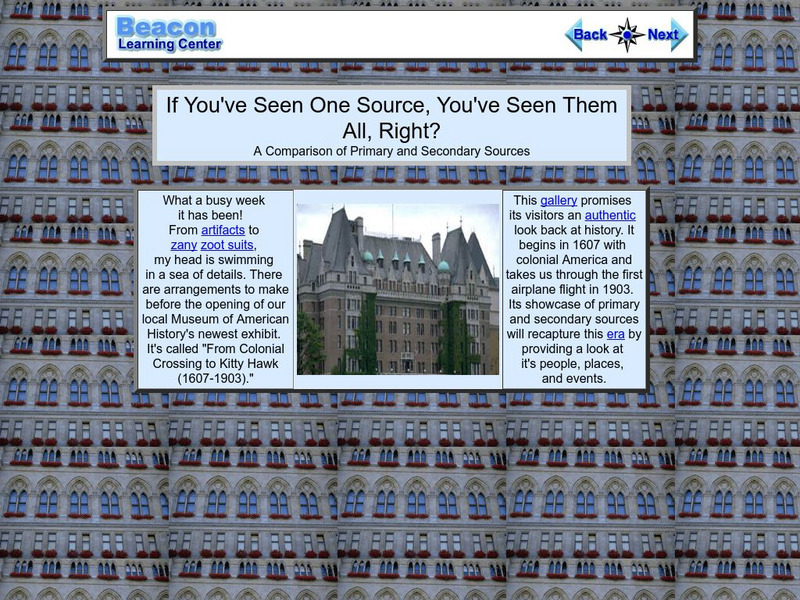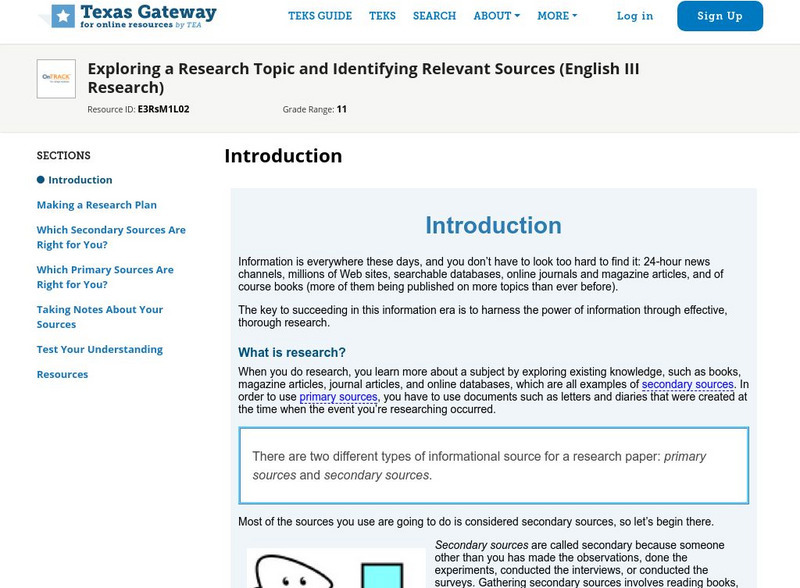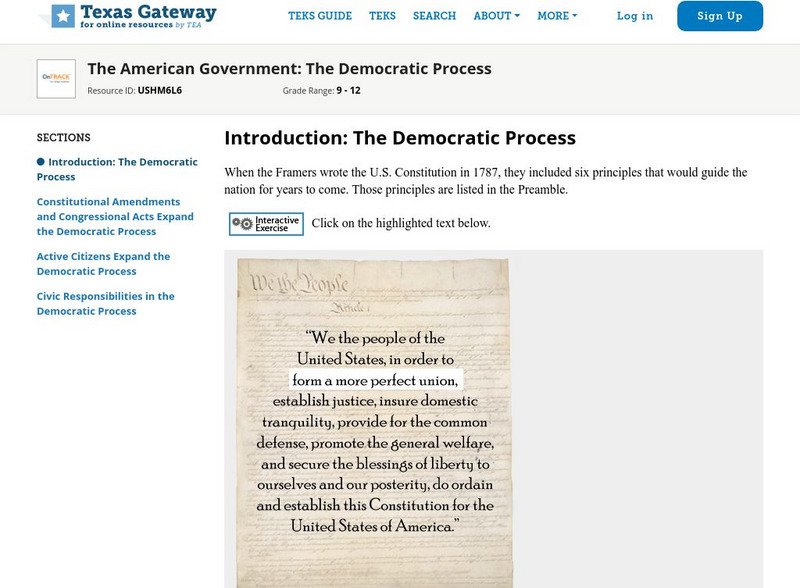Grammarly
Grammarly Handbook: Primary, Secondary, or Tertiary Resources
Definitions and examples of primary, secondary, and tertiary resources.
University of California
Uc Irvine: Distinguishing Between Primary & Secondary Sources
This site has an online quiz to test your knowledge of primary and secondary sources.
South Carolina Educational Television
Know It All: Primary and Secondary Accounts
Fifth graders will use letters from the Civil War to compare and contrast primary and secondary resources.
Grammarly
Grammarly Handbook: Evaluating Resources
This page explains the need for evaluating resources and offers links to rules for evaluating primary, secondary, or tertiary resources and determining if resources are good or bad.
Childnet
Childnet: Online Safety: Know It All Resources
Award-winning resources for teachers and parents. On this page you will find a selection of our Know IT All resources that were previously housed on our Know IT All website. It includes resources for Parents, Primary, Secondary Toolkits,...
PBS
Pbs Learning Media: Straight to the Source: Primary and Secondary Sources
Students discover what primary and secondary sources are and how to use them in this lesson from PBS Wisconsin Education. They watch video clips from the documentary "Wisconsin Hometown Stories: Neenah-Menasha," identifying the primary...
American Institutes for Research
Center on Response to Intervention: Multi Level Prevention System
Through this module, participants become familiar with the essential components of an RTI framework with a particular focus on the multi-level prevention system. The module covers the three levels of a multi-level prevention system...
Grammarly
Grammarly Handbook: Good or Bad Resource?
This page focuses on how to evaluate resources; it establishes criteria for determining good and bad resources. Primary resources are always good, but secondary and tertiary ones need to be evaluated more closely.
Beacon Learning Center
Beacon Learning Center: If You've Seen One Source, You've Seen Them All. Right?
This is a tutorial teaching the difference between primary and secondary research sources. It provides specific examples and asks students to answer questions along the way. Java is required.
Other
Live Binders: Primary Source Teaching the Web 2.0 Way K 12
This learning module consists of several tools for teaching with primary and secondary resources.
Other
George W. Bush Presidential Library: Teaching Primary and Secondary Sources
This comprehensive lesson plan provides a fact sheet, reusable worksheets, source scenarios, and assessments.
Texas State Historical Association
Texas State Historical Association: Water Resources [Pdf]
An activity guide where students refer to the Texas Almanac, which is free to download, for information needed to complete assigned tasks. In this lesson, they learn the difference between primary and secondary streams, then research and...
Texas Education Agency
Texas Gateway: Exploring a Research Topic and Identifying Relevant Sources
In this lesson, students learn how to plan their research, find relevant primary and secondary sources, and use those sources in your research papers. W.11-12.8 Sources/Integrate/Cite
Texas Education Agency
Texas Gateway: Gathering Appropriate Information (English Iii Writing)
[Accessible by TX Educators. Free Registration/Login Required] This lesson focuses on finding and evaluating relevant sources for a research project. It includes primary and secondary sources and print and internet sources. W.11-12.2...
PBS
Pbs Learning Media: The Unsung History Makers: Maria Moreno
In this interactive lesson, use primary and secondary sources such as video and audio to unravel the mystery of Maria Moreno, a woman who fought for farm labor rights before Cesar Chavez and Dolores Huerta formed the United Farm Workers....
Huntington Library
Huntington Library: The Corps of Discovery: The Lewis and Clark Expedition [Pdf]
In this lesson, 5th graders learn about westward expansion and the Lewis and Clark expedition. Includes background information for the teacher. Students explore primary and secondary resource readings on the Louisiana Purchase, President...
Huntington Library
Huntington Library: American Indians and English Settlers in Colonial America
In this lesson, 5th graders examine the relations between Indians and the settlers in the 1600s and 1700s. Background information for teachers is included. Students will work in groups to look at three different colonies and read primary...
PBS
Pbs: American Experience: Eyes on the Prize: Civil Rights Today, 2006
PBS American Experience website documentary on race relations and the current struggles for equality. Site offers primary and secondary resources and links to related material.
Nobel Media AB
The Nobel Prize: The Nobel Peace Prize 1906
Read about the peacemaking efforts for which Theodore Roosevelt was honored through the Nobel Peace Prize. This Nobel E-Museum website includes both primary and secondary resources as well as links and titles of suggested readings for...
Nobel Media AB
The Nobel Prize: The Nobel Prize in Physiology or Medicine 1930
The Nobel Foundation provides this site about Karl Landsteiner, a scientist who received the 1930 Nobel Prize in Medicine "for his discovery of human blood groups." This website includes both primary texts and secondary resources and an...
Nobel Media AB
The Nobel Prize: The Nobel Peace Prize 1983: Lech Walesa
Use this site to learn about the 1983 recipient of the Nobel Peace Prize, Lech Walesa, through primary and secondary resources as well as video clips.
Nobel Media AB
The Nobel Prize: The Nobel Peace Prize 1957: Linus Carl Pauling
Read about Lester Bowles Pearson (1897-1972 CE), the 1957 recipient of the Nobel Peace Prize. This website includes both primary and secondary resources and a "Selected Bibliography," for further research and reading.
Texas Education Agency
Texas Gateway: The Problem of Child Labor in the Progressive Era
After analyzing primary and secondary resources about the child labor, the students should be able to draw conclusions about the need to reform child labor practices.
Texas Education Agency
Texas Gateway: The American Government: The Democratic Process
Given primary and secondary resources, students will be able to identify and analyze various methods of expanding the right to participate in the democratic process.












